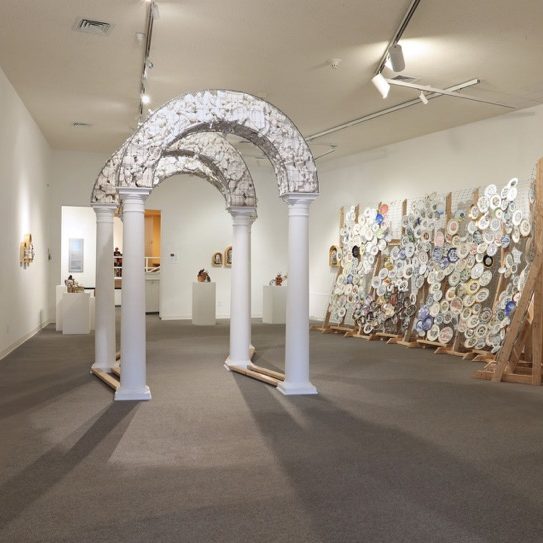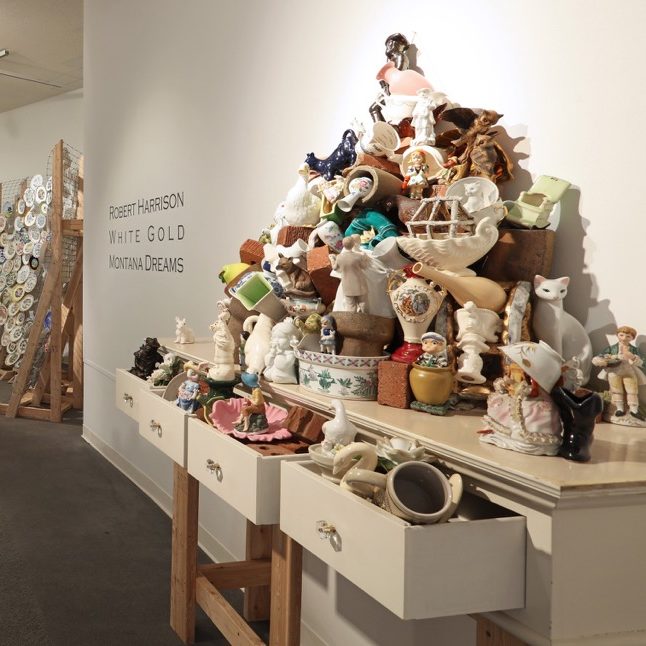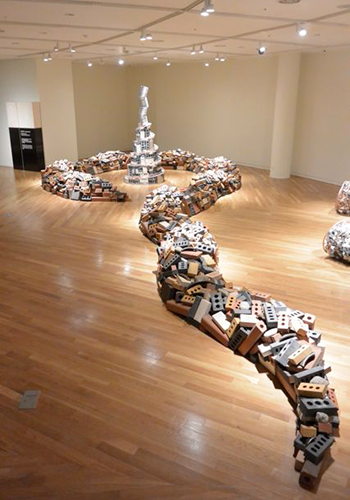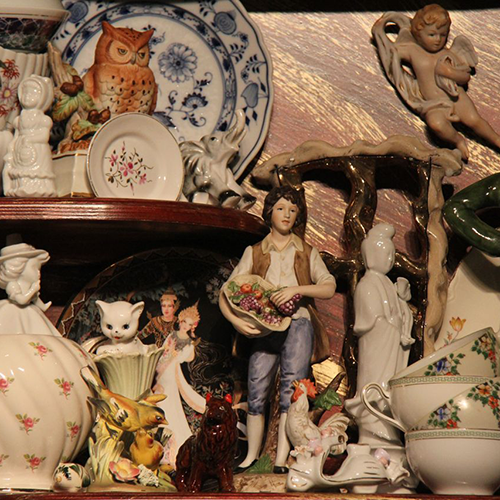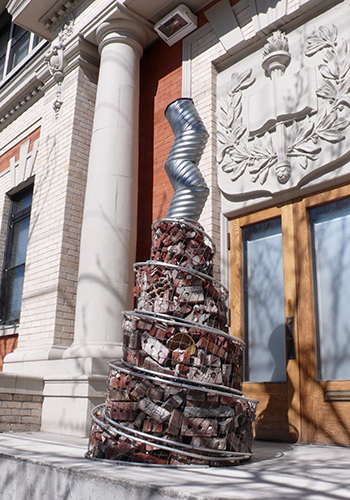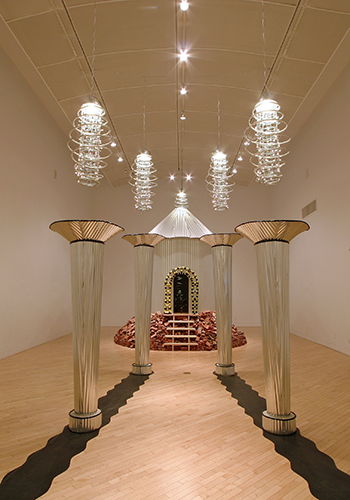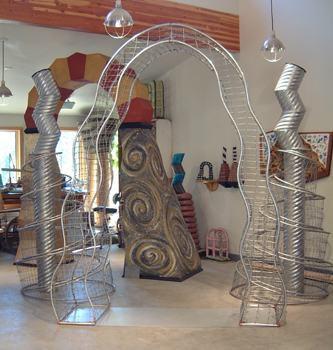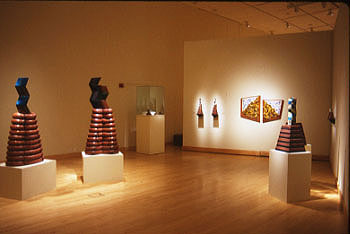Museum Installations
Robert Harrison – Danish Work Exhibition – Montana Arts Council – Artist Innovation Award 2020
I’ve been fortunate to have had the opportunity to travel extensively internationally over the past 30 years. One of my brick mentors, Ulla Viotti has been working at a famous brick factory in southern Denmark for many years. The Petersen TEGL brick factory has forged its worldwide reputation with hand-made black fired brick. Christian Petersen owns and runs the factory with global distribution of Petersen TEGL bricks used by some of today’s most famous architects. Through Ulla Viotti, the WABA group of brick artists were invited to work at the factory for a month, creating work for an exhibition and permanent outdoor brick sculptures. In late 2019 I received 3 large wooden crates of work I had made in the Petersen factory from the Danish WABA exhibition. I was thrilled to have my brick pieces in Montana. Concurrently I was honored to receive the 2019–2020 Artist Innovation Award from the Montana Arts Council, which requires an exhibition of the artists work. I was very pleased to be given the opportunity to exhibit my Danish work at the Holter Museum of Art in the spring of 2020.
The exhibition featured a dozen large black-fired brick clay slabs or plates 24” x 24” x 2.5” thick each. The large thick plates had been incised by hand when wet, and then brushed with thick white slip. The gold leaf on interior spaces was applied post firing. The plates illustrate some of my artistic vocabulary of shapes and symbols. Additional works in the exhibition include a series of Petersen TEGL brick houses, a series of tiny hand-built houses grouped together as villages, a few intentionally altered bricks and a collection of Danish flint stones and vintage brick from the edges of the fjords adjacent to the brick factory. The pieces are available with prices on request.
- Spring 2020
- Holter Museum of Art - Helena, Montana USA
Triple Divide and Governor’s Hutch
Triple Divide along with Governor’s Hutch were installed at the Yellowstone Art Museum as part of the 2018 Montana Triennial Exhibition. The museum curatorial staff sited the two pieces on either end of the YAM’s large second story gallery space. As with the previous installations of these works, visitors were encouraged to walk through the arches and visually explore the layered porcelain installations.
- July – September 2018
- The Montana Triennial Exhibition; Yellowstone Art Museum - Billings, Montana
White Gold: Montana Dreams
This installation and exhibition opportunity at the Belger Craneyard Exhibition Space allowed me to exhibit the work that had been previously installed at the Holter Museum of Art in 2016, and bring the work to a new mid-west audience in Kansas City, MO.
- September 2017 – February 2018
- Belger Craneyard Exhibition Space - Kansas City, Missouri
White Gold: Montana Dreams
I was given an opportunity to create a ceramic environment at the Holter Museum of Art in Helena, Montana; White Gold: Montana Dreams was the result. A couple of years of careful planning along with a fortuitous gift of biscuit-fired white-ware gave the exhibition its focus. White Gold does indeed refer to porcelain and my 3-year obsession with collecting inexpensive porcelain ‘treasures’ from local thrift stores.
- June – August 2016
- Holter Museum of Art - Helena, Montana
Construction of White Gold: Montana Dreams 2016
Construction of White Gold: Montana Dreams began in January 2016 in my Granitewood Studio west of Helena. I began with the Porcelain Cloud installation piece, building the framework from wooden 2×4’s in two undulating parts that were designed for the gallery space at the Holter Museum of Art in Helena. Galvanized steel woven wire horse fencing was then attached to the front face of the framework. Steel plate hangers were attached to a selection of about 300 collected vintage porcelain plates and a test panel of porcelain plates was assembled in the studio.
- 2016
WABA at the Clayarch Gimhae Museum of architectural ceramics
(Republic of Korea)
As a founding member of WABA (World Association of Brick Artists) I was included in an invitation to create and install a large-scale indoor installation at the Clayarch Gimhae Museum of architectural Ceramics in Korea. 5 WABA artists were invited to spend 5 weeks building work for the exhibition that opened in late February and runs through mid-August 2015.
My piece titled Elementary Brick is comprised of a 75’ long undulating serpentine brick line, a spiraling stack form and 3 smaller spiraling pod forms filled with brick and ceramic shards.
- 2015
- 40’ Long x 20’ Wide x 8’ High
- Clayarch Gimhae Museum - Gimhae, Republic of Korea
Re-CLAIMed: WHITE GOLD
Objects from Helena, Montana Collections
For this project, I wanted to create a life size replica of one of the Zwinger (Porcelain Museum in Dresden, Germany) installation arched niches, by building a recessed wooden arch form with interior shelves that would contain an homage to collecting porcelain in Helena, Montana. Dozens, perhaps hundreds of collected porcelain objects are installed into the frame, creating an intense optical experience for the viewer, full of color and shapes. The work is intended to create a visual blast for the viewer and provide a contemporary counter-point to the obsessive collecting of August the Strong, the 17th Century King of Poland and Elector of Saxony.
- 2015
- Holter Museum of Art - Helena, MT
Bray Timeline Arch
This installation at the Holter Museum of Art was created for the exhibition Big Clay, a group of large-scale ceramic installations in the Holter galleries in 2012. The framework is made from galvanized steel horse fencing and aluminum tubing. I received permission to mine a large shard pile at the Archie Bray Foundation for the Ceramic Arts for the interior fill material. The shards trace a 25 year history of the Bray Foundations resident artists.
- 2012
- 6' Wide x 2' Depth x 9' High
- Holter Museum of Art - Helena, Montana
MAM Stacks
MAM Stacks were installed at the Missoula Art Museum for the exhibition Persistence in Clay: Contemporary Ceramics in Montana. One stack was installed on the exterior of the museum and one in the interior, with an exterior wall separating them. The galvanized steel culvert pipe and horse fencing material used in the MAM Stacks is prevalent in the rural ranching communities in Montana and western North America. Aluminum tubing accents the spiraling form of the stacks.
- 2011
- Missoula, Montana
- 4' Diameter at base x 9' High each stack
- Missoula Art Museum - Missoula, Montana
The Architecture of Space: Montana Vernacular
The Architecture of Space: Montana Vernacular was designed and built at my Granitewood studio and then installed at the Holter Museum of Art. My challenge was to utilize the fantastic space of the then named High Gallery with it’s 20’+ vaulted ceiling. It took the better part of a year to design and build. Installation took a week with a great crew of staff and friends. The spiraling chandeliers above each column were meant to elevate the eye as one experienced the piece. The large silo element was chosen to visually anchor the piece to the space and is a reference to the grain silos that dot Montana’s landscape. The bricks used in the silo skirt were borrowed from the Archie Bray Foundation for the Ceramic Arts, remnants of brick production at the Western Clay Manufacturing plant. Viewers were encouraged to enter the silo and encounter the energy core in a pile of porcelain ceramic treasures.
- 2009
- Helena, Montana
- 45’ Length x12’ Wide x16’ High
- Holter Museum of Art - Helena, Montana
Tile Houses at Turman Larison Contemporary
I have been working with Quarry Tile Company in Spokane, Washington since 2004 when I was commissioned to build a large-scale outdoor architectural sculpture for their factory entrance. The finished piece, Quarry Tile Gateway, gave me the opportunity to research and explore the ceramic tile technology at QTCo. In 2008 I was working towards a solo exhibition of new works at Turman Larison Contemporary and came up with an the concept of building prototypical square tile houses.
- 2009
- Four sizes; from smallest 6" Square x 6" High to largest 14" Square x 15" High
- Turman Larison Contemporary - Helena, Montana
Sentinal Stacks and Arch
Site-specific architectural installation; galvanized steel culvert pipe, galvanized steel mesh fencing, aluminum tubing, brick, ceramic elements
- 2004
- 9' High x 12' Wide x 3' Deep
- Winnipeg Art Gallery - Winnipeg, Manitoba, Canada
Santa Ana Stacks
Site-specific architectural installation; salt-fired hard brick and pottery shards, galvanized steel fencing, aluminum cable tubing, galvanized steel culvert pipe
- 2003
- Orange County Center for Contemporary Art - Santa Ana, California
Celestial Gateway: Celestial Stack
Site-specific installation comprised of 6 sculptural elements: arch, stack, and 4 columns; steel, cement, ceramic tile, aluminum, wood, gold leaf
- 2001
- 30' Long x 16' Wide x 9' High
Celestial Alignments Exhibition
Sponsored by the Quarry Tile Company
- Jan 19th - April 11th, 2001
- Jundt Art Museum - Gonzaga University, Spokane, Washington
Australian Gateway
Site-specific architectural installation; corrugated steel, cast concrete, cast stabilized adobe, wood, lava rock, gold leaf
- 1992
- 40' Long x 40' Wide x 10' High
- University of South Australia Museum of Art - Adelaide, Australia
Art n’ Architecture
Site-specific architectural installation; turned wood, carved and surfaced styrofoam elements, powder-coated steel, cast ceramic elements, gilded window frames, lava rock
- 1992
- 50' Long x 24' Wide x 10' High
- Holter Museum of Art - Helena, Montana
Historical Fragements
Site-specific architectural installation; stabilized adobe and stucco
- 1987
- 20' Diameter x 5" High
- Alberta College of Art Gallery - Calgary, Alberta, Canada
Banff Colonnade
Site-specific architectural installation; stabilized adobe, stucco, turned wood, stone and gold leaf
- 1987
- 40' Long x 6" Wide x 7' High
- The Banff Centre - Banff, Alberta Canada













